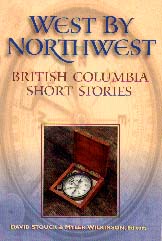|
________________
CM . . . .
Volume V Number 8 . . . . December 11, 1998
excerpt: Pretty as it was, it looked lifeless, and so to the Raven, quite boring. He gave a great sigh, crossed his wings behind his back and walked along the sand, his shiny head calked, his sharp eyes and ears alert for any unusual sight or sound. ... To his delight he heard and answering cry, or to describe it more closely, a muffled squeak. At first he saw nothing, but as he scanned the beach again a white flash caught his eye, and when he landed he found at his feet, half buried in the sand, a gigantic clamshell. When he looked more closely still, he saw that the shell was full of little creatures, cowering in terror of his enormous shadow. Well, here was something to break the monotony of his day, but nothing was going to happen as long as the tiny things stayed in the shell.From living a "simplified life" on one of the Gulf Islands, to swimming at English Bay in Vancouver, to the shadowy rain forests of the Queen Charlotte's are only some of the settings in West by Northwest: British Columbia Short Stories, a collection whose authors and stories are as varied as the geography of the province in which they are set. The collection opens appropriately enough with a Haida myth, "Raven and the First Men" retold by Bill Reid and Robert Bringburst, which tells of how Raven, on the look out for something interesting, one day discovers the first men cowering in a giant clamshell along the beach. Two short Haida legends by Pauline Johnson and three stories by Emily Carr help further to ground this collection in terms of the meeting of cultures, Johnson's "The Lost Island" telling of the coming of the whites to the west coast, while Carr's "Sophie" tells of her friendship with a First Nations woman, who has buried each of her twenty-one children. The rest of the collection reflects this cultural diversity, the white, First Nations, African/American, Chinese, and Russian, all contributing something to the imaginative landscape of the region, which is in turn set against the physical landscape of the city, the mountains, and the sea. And it is this landscape that figures so repeatedly into the varied styles that make up this collection. Two stories that reflect this range both in style and representation of the landscape are Jack Hodgins' "Earthquake" and Patrick Lane's "Mill-Cry." Hodgins has a light touch in telling the story of the earthquake of '46, using a first person narrator to describe how the "... scariest thing about quakes is that they change the way a fellow looks at the world." The quake affects everyone, in particular the narrator's uncle Toby, who forever afterwards tells anyone who will listen about how Comox Lake drained like a bathtub before slowly filling again, with "tangled knots of golden brown kelp and furious crabs" to tell the tale of where the water had been. In contrast to Hodgins, Lane's "Mill-Cry" is as stark and frozen as the uninsolated trailer in the snow-bound mill town three hours north of Kamloops where the story is set. This vignette is thick with a sense of clenched waiting, as a man sits at the kitchen table, smoking and playing solitaire, and waiting for the fifth whistle which will tell him there has been an accident at the mill. And yet this is only a taste of what this collection has to offer. Audrey Thomas's "Kill Day at the Government Wharf" is a strange story about a city woman bloodily baptizing herself into the "simplified life" of the Gulf Islands; and Caroline Woodward's Summer Wages is a mother's retrospective of working her first summer job at a roadside gas station and restaurant, more than an hour outside of Ft. St. John. Although this is a truly fine collection of regional fiction, it's only really suitable for grades eleven and up, and unquestionably would make a welcome addition to any course in Canadian literature at the University or college level. "Raven and the First Men" and the Johnson legends, as well as a variety of other stories in the collection would no doubt appeal to many teenagers. Nevertheless, the difficulty is that a number of these stories are simply about feelings and experiences most young people haven't encountered yet. It's hard to imagine many graduating high school students sticking with some of these stories on their own. But there's lots here to experience. And if young people only like a few of these stories, their parents and teachers will like more. Highly Recommended. William Thompson is completing his doctoral dissertation at the University of Alberta, Edmonton, Alberta.
To comment on this
title or this review, send mail to cm@umanitoba.ca.
Copyright © the Manitoba Library Association.
Reproduction for personal use is permitted only if this copyright notice
is maintained. Any other reproduction is prohibited without
permission.
Published by
TABLE OF CONTENTS FOR THIS ISSUE - DECEMBER 11, 1998.
AUTHORS |
TITLES |
MEDIA REVIEWS |
PROFILES |
BACK ISSUES |
SEARCH |
CMARCHIVE |
HOME
|

